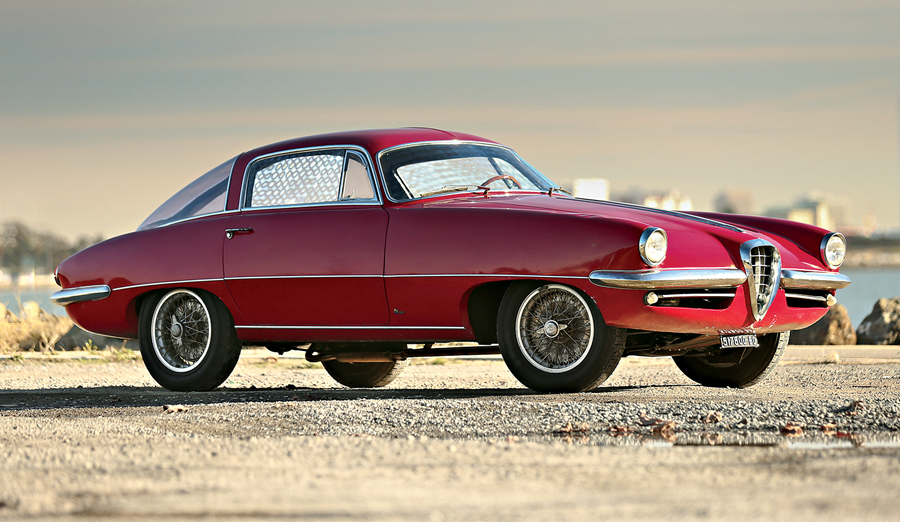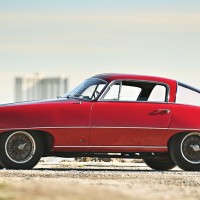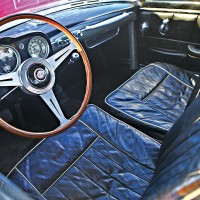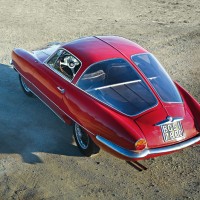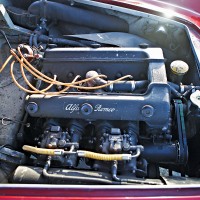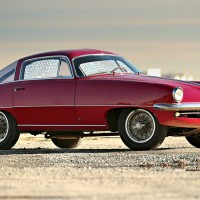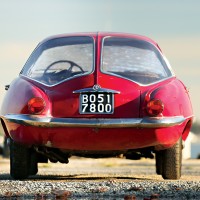SCM Analysis
Detailing
| Vehicle: | 1955 Alfa Romeo 1900C SS Boano Coupe |
| Number Produced: | 248 (all 1955 CSS) |
| Original List Price: | N/A |
| SCM Valuation: | This coachbuilt car is one of a kind, so the median price and high sale price are the same as this car’s purchase price |
| Tune Up Cost: | $475 |
| Chassis Number Location: | Engine bulkhead, stamped into metal |
| Engine Number Location: | Intake side of block |
| Club Info: | Alfa Romeo 1900 Register |
| Website: | http://www.ar1900reg.org |
| Alternatives: | 1953 Lancia B20 GT Zagato, 1953 Maserati A6G/2000 Frua, 1953 Fiat 8V Vignale |
| Investment Grade: | A |
This car, Lot 46, sold for $990,000, including buyer’s premium, at the Gooding & Company sale in Scottsdale, AZ, on January 29, 2016.
The appeal of 1950s Italian custom-bodied cars, known as fuoriserie, literally “outside of production,” is a compelling one.
While coachbuilding had all but died in the United States, Germany, France and the U.K. after World War II, arguably some of the greatest work by artisans on automotive chassis was done in Italy from 1946 through 1959 — with some great examples even following through the 1960s.
Defying logic and a very difficult marketplace, these designers and craftsmen displayed the fruits of an almost limitless imagination on a variety of racing, luxury, sporting and even humble family cars.
Carrozzeria Boano built four variations on this basic theme, three on Alfa chassis, one on a Fiat platform. The last two were rather more conventional than the initial two.
A cousin to our subject car
The first was a rebody of a 1952 Alfa Romeo 6C 3000CM, a 3.5-liter, 6-cylinder sports racing coupe built by Carrozzeria Colli and driven by Juan Manuel Fangio to 2nd place in the 1953 Mille Miglia and to a DNF at the 24 Hours of Le Mans the same year. Retired, it was sent to Carrozzeria Boano and given a completely new sleek look, with the futuristic split rear window and sharply tapering profile and plan views.
This race-proven car was either given or sold to Argentine dictator and Italian car enthusiast Juan Peron. That Fangio had driven it was surely an inducement. It is believed that the designs for these cars came from the pen of Gian Paolo Boano, son of the founder Felice Mario Boano. The styling shows inspiration from the 1952 Disco Volante spider by Carrozzeria Touring as well as influences of the three Carrozzeria Bertone B.A.T. aerodynamic studies on the 1900 platform.
A very special Alfa Romeo
Our subject car is the second Alfa, a 1900 short-chassis Super Sport coupe. This car is blessed with the 1308-series version of the DOHC inline 4-cylinder engine, using a double-chain system to time the cams and a second chain tensioner idler. The redesigned cylinder head also resulted in a larger 1,975-cc displacement. These engines were fitted in all the Zagato-bodied competition 1900C SS models, and the details of the Boano coupe show clear thinking about racing needs.
I first saw this car up close and personal at the Rétromobile show in Paris in February 2014 on a stand. I was immediately taken with it, as I had known the 6C 3000CM years ago when the late, great Henry Wessells III owned it and it was still in its Boano suit before his heavy crash at the Pittsburgh Vintage Grand Prix. Afterwards, Wessells had it rebodied in Italy to a copy of its original Carrozzeria Colli body, which that car still wears today.
A highly original car
The air cleaner in our subject car is mounted low, just behind the under-bumper grille, with a long plenum carrying the cool air to the intake manifold. There are also cooling ducts for the giant finned and ventilated front brake drums. This 4-cylinder chassis was created with the more powerful 6C 3000CM clearly in mind. There is no record of it having been used in anger, but it was built with that capability in mind.
It is one of the pleasant miracles of automotive history that this remarkable car managed to survive with minimal modification and deterioration. The first, and most obvious, change was to the color scheme, from the striking pale yellow and black it sported on the Turin Show floor and in early magazine coverage to the rather more predictable red in which it is currently finished.
Clearly done some decades ago, probably to make it look more like the Peron coupe, the paint of the 1900 was not terribly carefully applied. The car stayed in static storage for many years, almost certainly for most of its life in the legendary Righini collection. Luckily, the interior remained untouched and still shows all of its original materials and finishes in good condition. Very few of the special competition pieces are missing, and those that are may be easily replaced.
The body is in good condition, although the dents on the top of the right front fender and evidence of electrolytic corrosion on some panel edges are plainly visible. It is fair to say that any consideration of preservation has to stop with the indifferent quality of the color-change paint finish and some incorrectly replaced trim pieces. The interior could be saved, but it would be a challenge in many international concours settings to explain to the judges why the decision was made. Perhaps in a more enlightened future it will be possible.
Nevertheless, a restoration is ahead
In the event, this car will make a spectacular statement on the road and show arena once again when a complete, correct and sympathetic restoration has been done.
An expert shop will be able to save the original, now somewhat brittle, alloy body — while making those repairs that are necessary. The original upholstery will be carefully removed, saved and used as patterns for the new soft trim, and the original Autovox radio will produce mellow sounds again.
It will astound once more in its two-tone livery, and its top-specification engine will roar to life.
Now we come to the price paid. The auction company asked interested parties to consult with a car specialist for the estimate. This is commonly done when a difficult-to-value car comes to market, as it can be challenging to find appropriate comparables.
The estimate was stated to have been $1.1m–$1.3m, as a specialist described the car as “…close to a B.A.T. as you’re going to be able to buy.” I’m not quite sure about that, but I did know at least five collectors who were keenly interested in the car.
Inside the tent the day it sold, the Alfa provided the kind of drama for which auction houses and audiences alike live. Two experienced Italian car enthusiasts battled toe-to-toe on opposite sides of the room for the car in $10k increments until the new owner had his prize.
Worth the price
This car could quite likely absorb the better part of $500k before it re-emerges to public view, but at that, I still don’t feel the owner will be upside down. I’m told that the new owner plans to do the first-class restoration this car deserves, returning it to the original colors, showing it in top international concours and then running it in the Mille Miglia Storica.
While it is neither a B.A.T. nor a Disco Volante, it is something equally compelling: the realization of unfettered Italian mechanical and aesthetic genius, a masterpiece of the fuoriserie genus. My verdict on the transaction? Well sold and well bought. If you disagree, find the other one. ♦
(Introductory description courtesy of Gooding & Company.)
